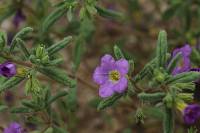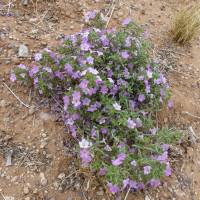|
|
 Leaves Anthony Mendoza @http://swbiodiversity.org, Usage Rights: Attribution-Non-Commercial (CC BY-NC) |  Plant Max Licher @http://swbiodiversity.org, Usage Rights: Creative Commons Attribution-ShareAlike (CC BY-SA) | | | | |
|
Origin:
Native
Life Cycle:
Annual
General Desc:
Ground-hugging, forms mats of trumpet-like blooms. With good rainfall the flowers carpet large areas of desert with color. Often called sandbells due to its preference for sandy soils and its flowers which look like upright bells.
Identification notes: A small annual. Stems, leaves covered with long stiff hairs. Leaves are narrow, widest near their tip, tapering to their bases. Wide, bell-shaped purplish flowers a little less than 1/2 inch long, with petals that are quite a bit longer than the sepals.
Height:
2 to 12 inches
Habitat Description: Dry plains, mesas; gravelly, rocky and sandy soils in diverse habitats.
Plant Communities:
Desert Scrub, Interior Chaparral, Semidesert Grasslands, Pinyon Juniper Woodland, Montane Conifer Forest
Elevation: Below 7000 feet
Color:
Purplish
Shape:
Bell-shaped in round clusters
Tubular:
Y
Flowering Period:
Feb - Jun
Description:
Showy, funnel-shaped, 1/2 inch wide flowers have 5 rounded petal-like lobes, white and yellow throats and yellow stamens. Flowers are solitary in leaf axils or in small crowded clusters at branch tips.
Leaf Color:
Grayish-green
Leaf Type:
Simple
Leaf Shape:
Narrow
Leaf Margin:
Smooth
Leaf Attachment:
Basal and alternate
Leaves Clasp:
N
Hairs:
Leaves and stems
Spines:
N
Leaf Description:
Stems curved, often with abundant basal leaves; stem leaves 1/2 to 2 inches long, narrow, spoon-shaped, sticky, coarse hairs and a pungent odor; leaf tips are rounded; leaf edges partially rolled under toward the leaf underside (revolute).
Fruit Color: Yellowish-brown
Fruit Type: Capsule
Fruit Notes: Dry, oblong, narrow capsule 1/4 inch long; opens at maturity to release numerous tiny seeds.
Seed Notes: Egg-shaped, yellowish or orangish seeds are less than 1/16 inch long and half as wide with a net-vein pattern on the outside surface (reticulate).
|
|